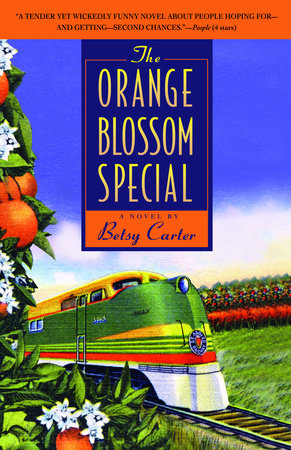The Orange Blossom Special Reader’s Guide
By Betsy Carter


1. The Orange Blossom Special refers to the first passenger train to connect New York to Miami, but it can also be seen as an overarching symbol in the context of this story. Thematically, what does it represent to Tessie and Dinah? To Victoria and Reggie? How can it be seen as a symbol of the American Dream?
2. What do you think of Tessie’s somewhat hasty decision to leave her past behind in search of a new start down South? Do you think her decision was in the best interest of her daughter’s well-being?
3. Once settled in Gainesville, both Tessie and Dinah develop ways to keep the memory of their dead husband and father, respectively, alive. Compare and contrast the way they are able to deal with their loss. Why do you think each keeps her method secret from the other?
4. From the first day of school Dinah seems to have an instant connection with Eddie Fingers. Describe their relationship. Every time Eddie flashed Dinah a certain number of fingers, she believed it was her dad talking to her. What do you think Eddie thought when Dinah would flash her fingers back at him?
5. How does each of the members of the Landy family deal with Maynard’s death? Do you think Crystal and Dinah are able to strengthen their friendship because of it? How?
6. After her husband’s death, Victoria Landy seems to find comfort and a sense of belonging in the unlikeliest of people. Why are J. Baldy and Sonia so important in her life? It seems she tries to ease the pain she suffers on the inside by perfecting herself on the outside. Does she ever find solace in this form of grieving?
7. Victoria believes that in some way widowhood has made her more compassionate. Do you agree? Though she saw Reggie as a hopeless and disgusting man, she somehow believed that "if she could fix [him], maybe it was possible that she could fix herself" (Chapter 13). How does their relationship grow over the course of the novel? What do they learn from each other? Do you think Reggie changes for the better? Why or why not?
8. At first glance, Tessie and Barone appear to be very different, but they are able to form a very strong and stable bond. How do their past experiences help forge such a profound understanding of each another?
9. The novel itself is divided into four distinct parts, each labeled with a different year. How does the author use the 1960s, full of social change, to strengthen the story? Describe the ways in which the civil rights movement and the politics surrounding the Vietnam War are woven throughout the novel, asserting their power to change even the most stubborn characters. Which character(s) seem to be the most affected by the political changes that occur throughout the story? Why?
10. How does the Vietnam War change Charlie’s outlook on life and his relationship with those he is closest to? How does the author use the power of suffering to truly bring people together in a way that nothing else can?
11. Think about the different mother-child relationships presented in this story. How does Tessie and Dinah’s relationship compare to that of Victoria and Crystal’s and to Victoria and Charlie’s? As the novel progresses, the most meaningful relationships seem to form between characters who are not related. Do you think these non-biological bonds are more telling? Why or why not?
Just for joining you’ll get personalized recommendations on your dashboard daily and features only for members.
Find Out More Join Now Sign In